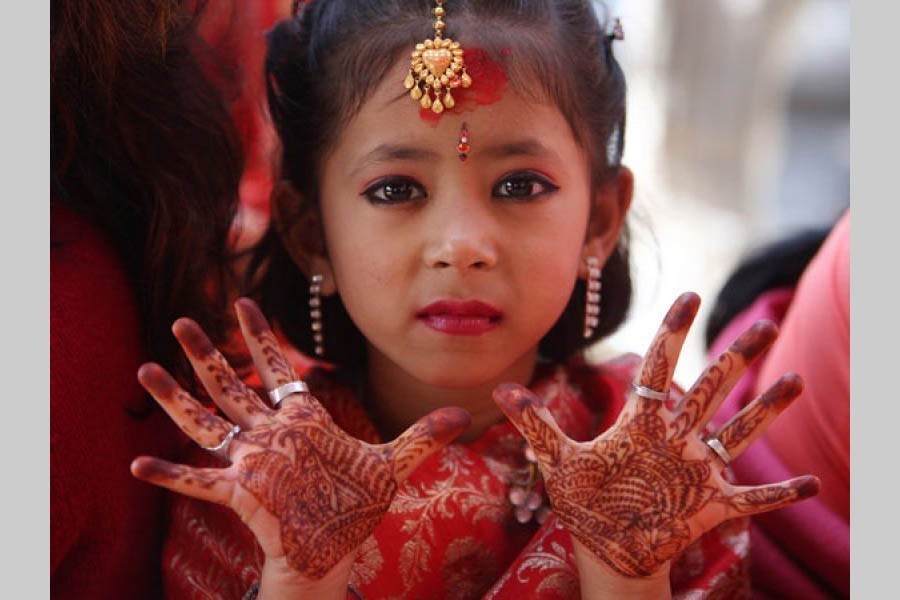In the past, it was mainly the traditional and social factors which played a critical role in the practice of marrying off teenage girls in rural areas. Throughout the passage of a century, the elders interpreted rural economy in their own ways. They added economic reasons to hasten the completion of the marriage of girl children. Many ultra-poor families considered the teenage girls a burden. The only way out, they deemed, was bidding adieu to the helpless teenagers, many of whom were below 12. Although many parents were not willing to part with their daughters, they had to give in to the social pressure. Economy-wise, few steps could be more pragmatic in the times immediately after the World War-II.
With the 21st century rural Bangladesh witnessing the multi-faceted socio-economic realities in a new mould, the case for child marriage remains stuck in its ancient roots. The women's rights activists in the independent Bangladesh since the 1980s-90s have been waging a crusade of sorts to put an end to the custom of child marriage. Development strategists were able to read between the lines. Upon taking an in-depth look at the realities prevailing in the rural areas, they were unanimous on the point that the institution of child marriage was inextricably linked to the desire to enjoy a solvency of sorts. After the state-backed all-out efforts to impart at least junior-level education to the girls, and keeping the brilliant ones apart for grooming them for the SSC level, the prospects for the girl students continued to become brighter. Girl students were relieved of educational expenses, with stipends introduced to whet their urge for continuing school education. But the age-old baggage of the custom of going ahead with early marriage of girls wouldn't leave the family heads. Despite being poverty-stricken, the parents turned to the education of their boy children, as they showed potential for earning for the family. Compared to them, no matter how talented the girls were, their future was viewed as being blocked. Few sectors were there in the villages to employ them. Thus marriage became the only way to give the ill-fated girls a 'new lease of life'. Teenage girls were the most unlucky. One fine morning discovering them to be quite 'grown-up', the mother or the father becomes busy searching for a suitable bridegroom. In most cases, the groom is quite older than the girl. Maybe they had the latent genius to emerge as a talented post-teenage youth. But their future is nipped in the bud while at the Grade 4 or 5 at school.
Given this bleak context, the State Minister for Women and Children Affairs has made an optimistic declaration. At a Dhaka meet last week the minister informed that the government was determined to reduce child marriage to zero level by 2040. Although the target might appear to be a pipedream to many, there are people who will take heart from the words. But they stress stringent laws against child marriage and mass-level awareness of the ills stemming from this practice.
Of late, days are changing fast in the rural expanse. The education authorities nowadays provide a lot of monetary incentives to the girl students. Thanks to the changing situation, the spirited little girls show their unwillingness to leave school. They know that once lured to the confines of home, they would be engaged in helping their mothers do the domestic chores. Their role at home is thus one of an unpaid assistant of their mothers. The greater world outside school or home is one filled with hungry wolves moving in the guise of both young and elderly males. Carnal harassment of the teenage and post-teenage school girls with their focus on the ladder set to take them to the broader world shatters them into pieces. Many a girl who is defiled finds themselves condemned to a cocoon. It's difficult to come out of it. Those who know how to cope with the adverse circumstances and take a strong defence can, somehow, manage to trace the ray of light --- the ray which will one day take them onto the brink of emancipation.
The task requires the firm commitment of the adolescent girls to cross the myriad social hurdles, mostly created by male chauvinists and lecherous males. Against the present fast-changing realities involving tolerably educated adult girls, who emerge from the rural background, teenage girls can see a wide horizon before them. It's only the spontaneous encouragement and patronage from the parents and the naighbourhood elders which they need badly. These essential supports can enable the ambitious girls to take great leaps forward. For the average rural girls, a secondary school certificate or one proving their higher secondary qualifications is sufficient to help them join the league of the financially self-made women. Many in today's rural areas have long emerged as powerful entrepreneurs. They have money, socio-political clout and a strong say in every local crisis. Had they given in to the normal community-based persecutions and the other exploitative menaces, they would have ended up being spent forces before they reached twenty. Not all teenage girls can be made to cower down with the threats of social isolation. These girls eventually learn how to fight their way out and settle down in a secure position.
To speak without mincing words, child marriage in Bengal, later in independent sovereign Bangladesh, has done great damage to the rural prospects for achieving collective uplift. It's heartening to see that in the male entrepreneur-dominated rural society, spirited and committed women have already carved out their distinctive positions. Had the undaunted women been married off at a tender age hoodwinking the legal provisions, their later lowliness might have added to the already lopsided rural economy. It's the ineffable female resoluteness and the power of forbearance which has made all the difference.


